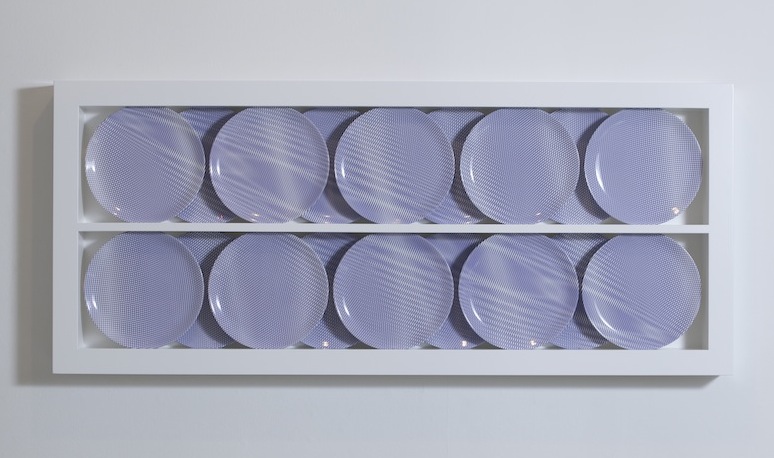Martin Smith uses the formal limitations of the vessel to investigate different conditions of space. In the foreword to the catalogue of Smith’s 1996 retrospective exhibition at the Museum Boijman’s van Beunigen, Rotterdam, the museum’s director, Chris Dercon, compared his innovative and influential career to that of the late Hans Coper. Dercon described Smith as “…the most abstract and geometrically orientated ceramist in England and possibly of our times.” What follows is Smith’s explanation of the thinking behind his plates. Look for his limited edition plate that will become available when CFile’s gallery, Ceramics Limited, premieres in February.
2 Corners-Shifted
Early in 2011 I made a work titled 4 Sides-4 Corners. This consisted of an array of 25 bone china plates mounted on the wall in a 5×5 square grit 1390×1390 mm. Working in Adobe Illustrator and making reference to Sol LeWitt, I drew a series of arcs from each corner and straight lines parallel to each side of the square all in increments of 10mm. The resultant drawing was divided into 25 circular sections and the resultant files used to produce digital on-glaze decals that were applied and fired onto the plates.

Martin Smith, 4 Sides-4 Corners, 2011. Bone china plates, digitally printed on-glaze enamel. 1390 x 1390 mm.
This was followed later in the year by a further plate work. Titled, 2 Corners, this took the form of 19 plates arranged in two offset rows, one in front of the other and contained within a ‘frame’, allowing the piece to function as wall based art work but with the potential for utilitarian use as each plate could be removed from the frame, in the same way that the dresser allows for the display of the dinner set. In this case the surface image consisted of circular arcs struck from diagonally opposite corners, the two sets interfering with each other in the same way that ripples caused by tossing two pebbles into a pool will interfere to either amplify or cancel each other out.

Martin Smith, 2 Corners, 2011. Bone china plates, Digital on-glaze transfers, MDF, Paint. 2800 x 95 x 366mm high.
More recent works such as 2 Corners-Doubled have taken this approach and added the notion of Phase. There is a piece by the ‘minimalist’ composer, Steve Reich, called “Electric Guitar Phase: (2001),” which is a new version of the 1967 “Violin Phase.” The arrangement begins with a basic repeating pattern played on one electric guitar. A second guitar enters in unison and then gets slightly faster so as to slowly move ahead of the first before gradually coming back into phase. 2 Corners-Doubled takes this notion and reworks it graphically. Working first from the top left corner of a rectangle. Circular arcs are drawn at 5 mm intervals. In a second Illustrator layer this series of arcs was stretched by 5% and superimposed on the first with the result that the lines begin perfectly superimposed, one on the other, but drift out of phase before coming back into alignment. This process was repeated from the bottom right corner resulting in the same interference as 2 Corners. In this case eighteen plates are arranged as two rows of 5, one positioned above the other, each with a second offset row of 4 behind.

Martin Smith, 2 Corners – Doubled, 2013. Bone china plates, digital in-glaze transfers, MDF, paint. 1493 x 640 x 105 mm. All images courtesy of the artist and Marsden Woo Gallery.
The single plate 2 Corners-Shifted, produced as a limited edition of 25 is in effect, what would be the central section of this last piece. Recent technical advances in digitally produced decals have led to the introduction of in-glaze colours. These are fired to a higher temperature, allowing the colour to sink into the glaze, rather than sit on the surface, as with on-glaze colour. However, exhaustive research has been necessary to determine the correct interplay of firing temperature, weight of line and CMYK balance to achieve this result.

Martin Smith, 2 Corners Shifted, 2013. Digital onglaze decal on bone china. Produced in an edition of 25. Available at the CFile Shop. www.cfileshop.org
Above text by Martin Smith.
Martin Smith (b. 1950) studied at Bristol Polytechnic Faculty of Art and Design and the Royal College of Art, London. Examples of his work are held in numerous public collections including the Victoria & Albert Museum, London; the National Museums of Modern Art, Tokyo and Kyoto; Los Angeles County Museum, California; Museum of Fine Arts, Houston; the Stedelijk Museum, Amsterdam; and the Museum Boijman’s van Beunigen, Rotterdam. He is Professor of Ceramics & Glass at the Royal College of Art, London.

Add your valued opinion to this post.